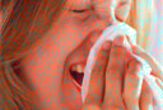Amid Avian Flu Fears, Other Bugs Far More Deadly

With fears of the avian flu whirling around the globe, researchers today pointed out that the immediate risk of death by other infectious diseases is far higher.
No one in the Western Hemisphere has even contracted the strain of flu being spread rapidly in Eastern countries by birds.
Officials fear the virus could eventually morph into a strain that can jump between humans and become a global pandemic. But for now the few dozen human deaths from the avian flu have resulted from direct contact with infected birds.
U.S. Deaths expected
Other strains of the flu virus, meanwhile, are likely to kill more than 35,000 U.S. residents this winter, assuming it is a typical year. And that's not the half of it.
Here are some hard-to-pronounce bugs that may well be on a doorknob near you: metapneumovirus; rhinoviruses; coronaviruses, parainfluenza; respiratory syncytial virus (RSV).
RSV kills 14,000 elderly people and high-risk adults every year, said scientists at the University of Rochester Medical Center. It is also the leading cause of bronchiolitis and pneumonia among infants, especially those under 6 months. In most cases, it goes away untreated.
Sign up for the Live Science daily newsletter now
Get the world’s most fascinating discoveries delivered straight to your inbox.
After a decade of effort, no RSV vaccine exists.
"A lot of cases that people think are from flu aren't really the flu at all, but other respiratory viruses like RSV," said Ann Falsey, who works in the university's Infectious Disease Unit. "At least with the flu, we have something to control it—a vaccine."
How they spread
The flu tends to spread when someone coughs, and the airborne virus lands on another person, or they cough and then touch the faucet or doorknob, Falsey and her colleagues say. Symptoms typically include fever and body aches.
RSV is more likely to produce a runny nose, a cough with mucus, and wheezing.
Like the common cold, RSV spreads mainly via large droplets on hard surfaces and even towels, and by shaking hands.
"RSV lives on objects including faucets, door handles, and change from the coffee shop, for quite awhile, for at least a day," said William Hall, a University of Rochester researcher who studies how diseases spread. "If you put your finger in your mouth, or touch your eye, or pick your nose, you're a spreader, to put it bluntly.
Same old advice
Your best defense hasn't changed for decades: Wash your hands.
"We've known for more than 100 years that hand washing prevents infection, but we still can't get people to wash their hands," said Falsey. "Hand washing is the simplest, most effective way to keep from getting sick and making others sick."
Falsey's advice was confirmed last year by a study that showed regular soap and a few seconds of scrubbing is the most effective way to rid your hands of germs. Yet another study revealed that only 83 percent of Americans wash their hands before leaving public restrooms.
The Center for Disease Control and Prevention (CDC) also recommends that everyone else over age 50 be vaccinated.
And if you think you have the flu?
Rest, drink lots of fluids and call a doctor immediately, the researchers say, because the flu can be treated effectively with new medications if caught within the first 48 hours.
Robert is an independent health and science journalist and writer based in Phoenix, Arizona. He is a former editor-in-chief of Live Science with over 20 years of experience as a reporter and editor. He has worked on websites such as Space.com and Tom's Guide, and is a contributor on Medium, covering how we age and how to optimize the mind and body through time. He has a journalism degree from Humboldt State University in California.










